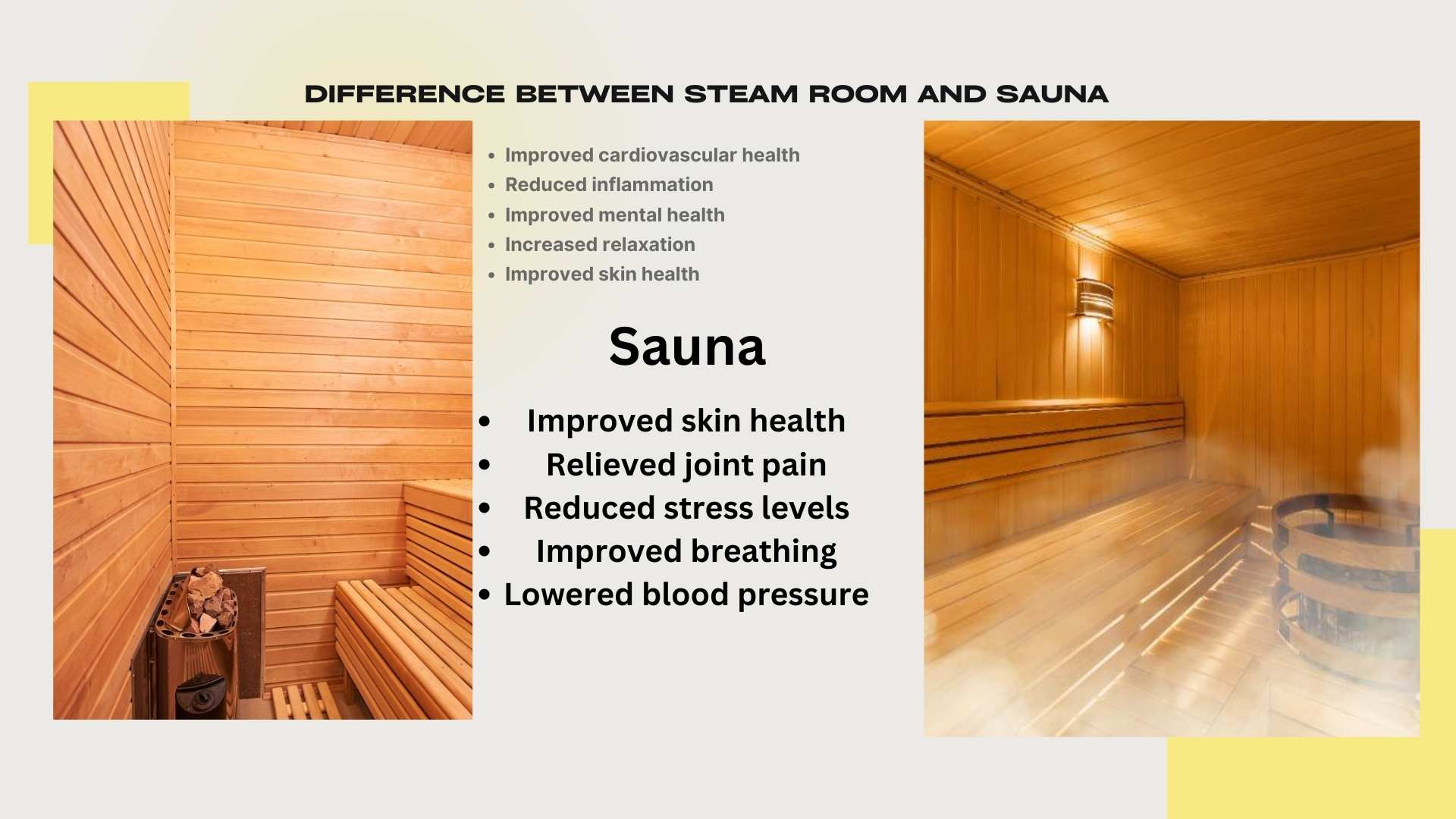
Wellhealthorganic.com:difference-between-steam-room-and-sauna-health-benefits-of-steam-room: Visiting a steam room or sauna is a relaxing way to unwind after a long day or a tough workout. Both offer a range of health benefits, including detoxification, improved circulation, and relief from muscle soreness. But what exactly makes these two types of hot rooms different, and what are the unique benefits of steam rooms? In this post, we’ll explore the key differences between steam rooms and saunas, and dive into the specific health benefits of steam rooms.
What Is Steam Room ?
A steam room is a heated room that is filled with steam. The humidity levels in a steam room are very high, typically around 100%, which can help to open up your airways and clear out any congestion. The warm moisture in the room also helps to promote blood circulation, which can help to reduce muscle soreness and promote healing after exercise.
Some of the health benefits of a steam room include:
- Improved skin health
- Relieved joint pain
- Reduced stress levels
- Improved breathing
- Lowered blood pressure
What Is Sauna?
Saunas, on the other hand, are dry rooms that have a higher temperature than steam rooms. The temperature in a sauna can range from 160°F to 200°F, which can help to promote sweating and detoxification. Saunas can also help to improve blood flow and circulation, which can lead to lower blood pressure and a reduced risk of heart disease.
Some of the health benefits of a sauna include:
- Improved cardiovascular health
- Reduced inflammation
- Improved mental health
- Increased relaxation
- Improved skin health
Wellhealthorganic.com:difference-between-steam-room-and-sauna-health-benefits-of-steam-room

Steam rooms and saunas are both popular options for relaxation and rejuvenation, but they are actually quite different. While both provide heat therapy, they differ in terms of temperature, humidity levels, and the way they work. In this article, we will explore the key differences between steam rooms and saunas, as well as the health benefits of steam rooms.
Difference Between Steam Room and Sauna
Temperature
The main difference between steam rooms and saunas is the temperature. Saunas are typically heated to between 160°F and 200°F, while steam rooms are usually kept at a temperature of around 110°F to 120°F. The higher temperature in saunas means that they are better for sweating out toxins and burning calories.
Humidity
Another key difference between steam rooms and saunas is the humidity levels. Saunas have low humidity, usually around 10% to 20%, while steam rooms have high humidity, usually around 100%. The high humidity in steam rooms can help to open up the airways and promote deeper breathing, making them a great option for people with respiratory issues.
How They Work
Saunas work by heating the air around you, while steam rooms work by adding moisture to the air. This moisture can help to soothe sore muscles and joints, as well as hydrate and nourish the skin.
Health Benefits of Steam Rooms
Steam rooms offer a range of health benefits, including:
Improved Respiratory Function
The high humidity in steam rooms can help to open up the airways and improve respiratory function. This can be especially beneficial for people with asthma, allergies, or other respiratory issues.
Stress Relief
Steam rooms can also be a great way to relax and relieve stress. The warmth and moisture can help to soothe the body and calm the mind, reducing feelings of anxiety and promoting a sense of relaxation.
Pain Relief
Steam rooms can also help to alleviate pain in the body. The heat and moisture can help to soothe sore muscles and joints, reducing inflammation and promoting healing.
Skin Health
The high humidity in steam rooms can help to hydrate and nourish the skin, leaving it soft, smooth, and glowing. Steam rooms can also help to unclog pores and remove toxins from the skin, reducing the risk of breakouts and other skin issues.
Steam rooms and saunas offer different benefits and are best suited for different purposes. While saunas are better for sweating out toxins and burning calories, steam rooms are great for promoting respiratory function, relieving stress, alleviating pain, and improving skin health. So, whether you prefer the dry heat of a sauna or the moist heat of a steam room, both can be great options for relaxation and rejuvenation.
Steam Room vs. Sauna

The primary difference between a steam room and a sauna is the type of heat they use. A sauna typically uses dry heat, generated by heating stones or other materials to a high temperature. The heat is then circulated throughout the room, creating a hot, dry environment. In contrast, a steam room uses moist heat, generated by boiling water to create steam. This steam is then pumped into the room, creating a hot, humid environment.
Different Types of Steam Room and Sauna: Health Benefits of Steam Room
A steam room is a type of heated room that is designed for relaxation and therapeutic purposes. It uses a humidifying steam generator to produce steam, which is then circulated throughout the room. A sauna, on the other hand, is a type of dry heat bath that originated in Finland. It uses a stove to heat up rocks, which then produce dry heat that is circulated throughout the room.
There are different types of steam rooms and saunas available, each with their own unique characteristics and benefits. The most common types include:
Traditional Saunas
Traditional saunas are the most common type of sauna. They use a wood stove to heat up rocks, which then produce dry heat that is circulated throughout the room. Traditional saunas are known for their relaxing and detoxifying effects. They can also help to relieve muscle tension and improve circulation.
Infrared Saunas
Infrared saunas use infrared heaters to emit radiant heat that is absorbed directly by the body. This type of sauna is believed to be more effective at detoxifying the body than traditional saunas. It can also help to relieve pain, improve skin health, and boost the immune system.
Steam Rooms
Steam rooms are similar to traditional saunas, but they use a humidifying steam generator to produce steam instead of dry heat. Steam rooms are known for their relaxing and rejuvenating effects. They can also help to improve respiratory health and relieve stress.
Portable Saunas
Portable saunas are a type of sauna that can be easily moved and set up in different locations. They are typically smaller than traditional saunas and use infrared heaters to emit radiant heat. Portable saunas are a convenient option for people who want to enjoy the health benefits of a sauna without having to install a permanent unit.
Steam rooms and saunas are both excellent options for relaxation and improving overall health. Each type of sauna has its own unique benefits, and choosing the right one depends on your personal preferences and needs. Regardless of which type you choose, incorporating a steam room or sauna into your routine can help to improve your physical and mental well-being.
Health Benefits of Steam Rooms
While both steam rooms and saunas offer a range of health benefits, steam rooms are particularly effective at promoting detoxification and improving respiratory health. The moist heat of a steam room helps to clear out your sinuses and lungs, making it easier to breathe. It also promotes sweating, which helps to flush out toxins from your body. In addition to these respiratory and detoxification benefits, steam rooms can also help to relieve stress and improve skin health. The humid environment can help to moisturize your skin and reduce the appearance of fine lines and wrinkles.
Health Risks of Steam Rooms
Steam rooms are popular in spas and gyms for their relaxing and detoxifying benefits. However, prolonged exposure to high temperatures and humidity in steam rooms can pose health risks. Here are some of the potential health hazards of using steam rooms:
Dehydration
Steam rooms can cause excessive sweating, leading to dehydration. Dehydration can cause symptoms such as dizziness, fatigue, and headaches. It is important to stay hydrated by drinking plenty of water before and after using a steam room.
Respiratory Issues
People with respiratory problems, such as asthma or allergies, may experience difficulty breathing in the high humidity of a steam room. The steam can irritate the airways, causing coughing and wheezing.
Skin Irritation
The heat and humidity of steam rooms can cause skin irritation, especially for people with sensitive skin. Prolonged exposure to steam can cause rashes, itching, and other skin problems.
Infections
Steam rooms can also be breeding grounds for bacteria and viruses. Inhaling contaminated steam can cause respiratory and other infections. It is important to use a clean and well-maintained steam room to reduce the risk of infection.
Cardiovascular Issues
The high temperature in steam rooms can cause an increase in heart rate and blood pressure. People with cardiovascular problems should avoid using steam rooms.
While steam rooms offer many benefits, they also pose health risks. It is important to use steam rooms in moderation and to be aware of the potential health hazards. If you have any pre-existing health conditions, it is best to consult with a doctor before using a steam room.
Conclusion
Wellhealthorganic.com:difference-between-steam-room-and-sauna-health-benefits-of-steam-room : Whether you prefer the dry heat of a sauna or the humid heat of a steam room, both offer a range of health benefits that can improve your overall wellbeing. However, if you’re looking for a hot room that can help to clear out your sinuses, promote detoxification, and improve your skin health, a steam room may be the better choice for you. So the next time you’re looking to relax and unwind, consider visiting a steam room to experience these unique health benefits for yourself.






